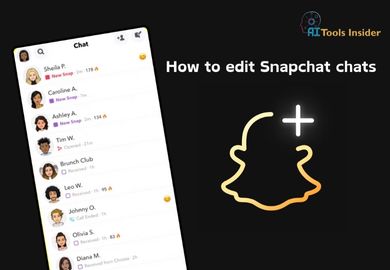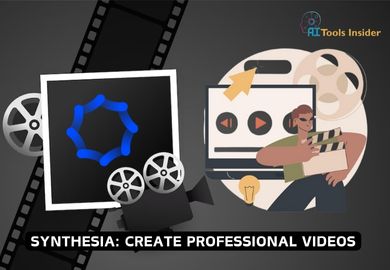Audioalter: AI Tool for Online Audio Equalization and Effects
- 519 Views
- May 17, 2024
The 10 Best AI Apps You Need to Try in 2024
- 409 Views
- May 20, 2024
What is Google Knowledge Graph
- 383 Views
- May 21, 2024
Best AI Voice Generator Tools for 2024
- 354 Views
- May 21, 2024
How to edit Snapchat chats with Snapchat Plus
- 386 Views
- May 21, 2024
Synthesia: Create Professional Videos to Promote Your Business
- 448 Views
- May 21, 2024
What Are the Best Tools to Create Free Videos with AI?
- 328 Views
- May 21, 2024
Trello: Organize Your Work and Life with this AI
- 494 Views
- May 21, 2024
Vizard AI: Transform your lengthy videos into viral clips with AI
- 405 Views
- May 21, 2024
Yuka: Scan and Control What You Eat with this AI App
- 395 Views
- May 22, 2024
Best Free AI Art Generator Tools to Unleash Your Creativity in 2024
- 370 Views
- May 22, 2024
How Generative AI Applications are Redefining Creative Expression
- 342 Views
- May 22, 2024
What is free ai image generator and how to use it
- 369 Views
- May 23, 2024
The Power of AI Data Analytics In Transforming Business Intelligence
- 376 Views
- May 23, 2024
Facetune: The Best App to Edit Your Photos with AI
- 460 Views
- Dev
- June 21, 2024
Whether you’re a podcaster, musician, content creator, or just someone looking to improve the quality of your audio recordings, having access to professional-grade editing tools LIKE Audioalter can make all the difference. Audioalter is an online audio editing platform that’s revolutionizing the way we approach sound manipulation.
Audioalter has quickly risen to prominence in the world of online audio editing tools, offering a user-friendly interface that caters to both beginners and advanced users.
This comprehensive guide will walk you through everything you need to know about Audioalter, from its basic features to advanced techniques that will take your audio editing skills to the next level.
What is Audioalter?
Audioalter is a web-based audio editing tool that allows users to manipulate and enhance their audio files without the need for complex software installations.
Developed by a team of audio enthusiasts and software engineers, Audioalter aims to make professional-grade audio editing accessible to everyone, regardless of their technical expertise.
Key features
Equalization: Fine-tune the frequency balance of your audio
Audio Effects: Apply reverb, bass boost, and other enhancements
File Format Conversion: Convert between various audio formats
Noise Reduction: Clean up background noise for clearer sound
Volume Normalization: Ensure consistent volume levels across your audio
Stereo Enhancements: Improve the spatial quality of your recordings
Vocal Remover: Isolate or remove vocals from music tracks
Tempo and Pitch Adjustments: Modify the speed and pitch of your audio
Also Read: Descript – Revolutionizing Audio and Video Editing AI Tool
How to Use Audioalter
Getting Started:
To begin using Audioalter, simply navigate to their website (www.audioalter.com) using any modern web browser. The intuitive interface will greet you with options to upload your audio file or start a new project.
Basic Editing:
- Upload your audio file by clicking the “Upload” button or dragging and dropping your file into the designated area.
- Once your file is loaded, you’ll see a waveform representation of your audio.
- Use the toolbar at the top of the interface to access basic editing tools like equalization and reverb.
- Apply effects by selecting the desired tool and adjusting the parameters to your liking.
- To save your work, click the “Export” button and choose your preferred file format and quality settings.
Advanced Features:
For more complex tasks like noise reduction or vocal removal:
- Select the appropriate tool from the advanced features menu.
- Follow the on-screen instructions to analyze your audio and apply the effect.
- Use the preview function to fine-tune your settings before applying them to the entire track.
File Conversion:
Audioalter supports a wide range of audio formats, including MP3, WAV, FLAC, and more. To convert your file:
- Upload your audio file as usual.
- Click the “Export” button and select your desired output format from the dropdown menu.
- Adjust any additional settings like bitrate or sample rate if needed.
- Click “Convert” to process your file.
Practical Tips:
- Always work with a copy of your original file to avoid irreversible changes.
- Use the “undo” function liberally as you experiment with different effects.
- For podcasts, focus on clarity and consistent volume levels.
- When editing music, be subtle with your adjustments to maintain the original character of the recording.
Use Cases for Audioalter
Podcasters:
Audioalter is a game-changer for podcasters looking to enhance their audio quality. Use the noise reduction feature to eliminate background hum, apply equalization to boost voice clarity, and utilize the volume normalization tool to ensure consistent levels throughout your episode.
Musicians:
For musicians, Audioalter offers a quick way to polish tracks or create remixes. The vocal remover tool can isolate instrumentals or vocals for further editing, while the various audio effects can add professional-sounding touches to your music.
Content Creators:
Video content creators can significantly improve their production value by enhancing the audio tracks of their videos. Use Audioalter to clean up dialogue, add atmospheric effects, or balance background music with voiceovers.
General Users:
Even casual users can benefit from Audioalter’s simplicity. Enhance personal recordings, improve the quality of audiobooks, or clean up old audio files with just a few clicks.
Also Read: ElevenLabs: Generate Realistic Voice Audios with this AI
Comparing Audioalter to Other Audio Editing Tools
While Audioalter stands out for its ease of use and robust feature set, it’s worth comparing it to other options in the market:
Online Tools:
Compared to other online editors like TwistedWave or BearAudio, Audioalter often offers a more comprehensive suite of tools and a more intuitive interface. However, some users might find specialized tools better suited for specific tasks.
Desktop Software:
When compared to desktop applications like Audacity or Adobe Audition, Audioalter’s main advantage is its accessibility and lack of installation requirements. However, professional users might prefer the more extensive control offered by full-fledged desktop software for complex projects.
Tips and Tricks for Maximizing Audioalter’s Potential
Explore All Features: Don’t be afraid to experiment with tools you might not typically use. You might discover new ways to enhance your audio.
Custom Presets: Save your frequently used settings as custom presets to streamline your workflow.
Batch Processing: Take advantage of Audioalter’s batch processing capabilities to apply the same effects or conversions to multiple files simultaneously.
Troubleshooting: If you encounter issues, check Audioalter’s support documentation or reach out to their customer service team for assistance.
Also Read: Speechelo: Revolutionizing Text-to-Speech for Content Creators
Conclusion
Audioalter represents a significant step forward in making professional audio editing accessible to everyone. Its combination of powerful features and user-friendly interface makes it an excellent choice for a wide range of audio editing tasks.
Whether you’re a podcast producer, a budding musician, or simply someone looking to enhance their personal audio recordings, Audioalter provides the tools you need to achieve professional-quality results.
We encourage you to explore Audioalter for yourself and discover how it can elevate your audio projects. Don’t hesitate to experiment with different features and share your experiences in the comments below. For more information and to start editing, visit Audioalter’s official website at https://audioalter.com/.
Remember, great audio can make or break your content. With Audioalter at your fingertips, you’re well-equipped to create polished, professional-sounding audio that will captivate your audience.
Happy editing!
Frequently Asked Questions (FAQs)
What file formats does Audioalter support?
Audioalter supports most common audio formats, including MP3, WAV, FLAC, AAC, and more.
How can I achieve the best results with noise reduction?
For optimal noise reduction, select a small portion of your audio that contains only the background noise you want to remove. Use this as a sample for the noise reduction algorithm to analyze.
Where can I find additional help and resources?
Audioalter provides extensive documentation on their website, along with tutorial videos and a responsive support team.














